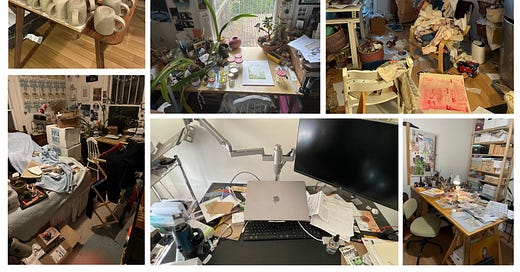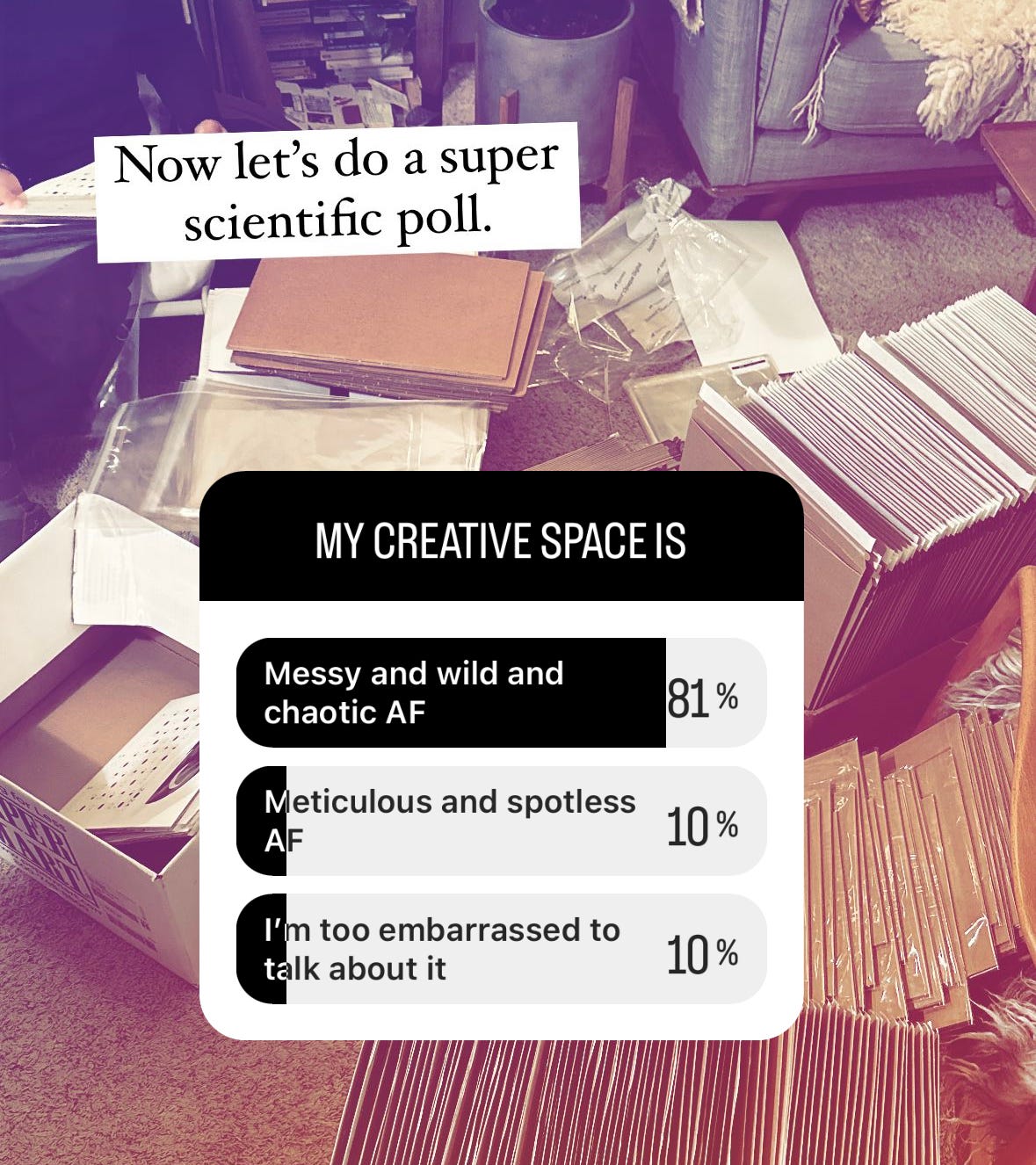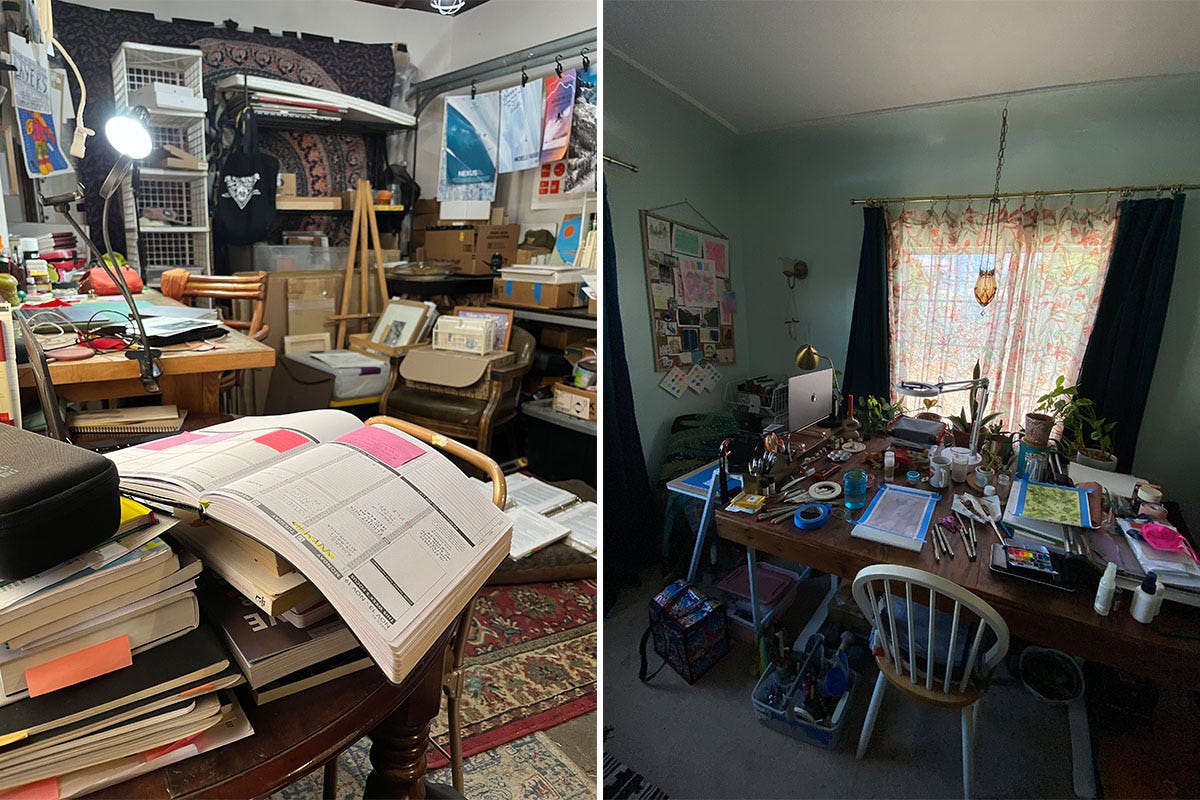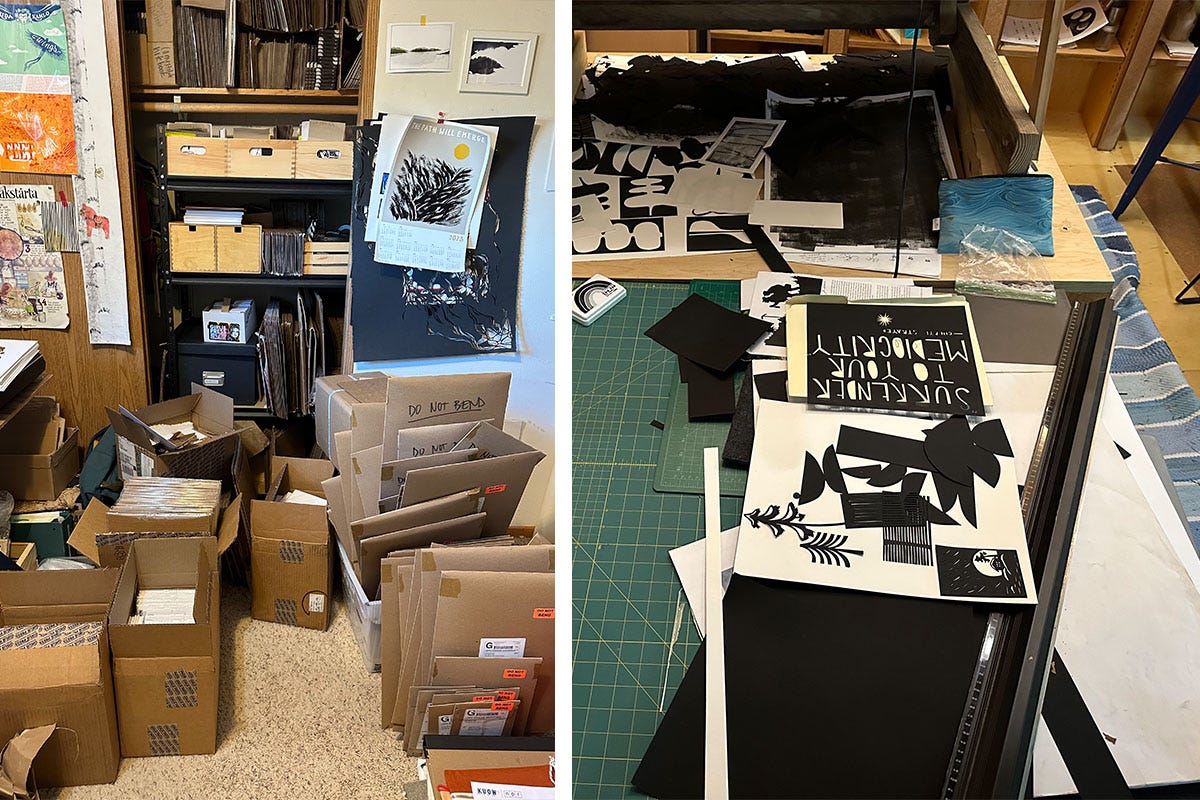Hello friends. There are a lot of new people here: welcome! I am so happy to have you here.
If you have been reading for a while and have been considering becoming a paid subscriber maybe today is the day? Paid subscribers get the weekend edition AND 24 Days of Making, Doing, and Being which starts on December 1st.
Around this time of year, my phone tends to fill up with messy studio photos.
This is a way of commiserating with fellow creative friends, particularly those whose jobs involve any kind of seasonal packaging and shipping. At this point, these photo exchanges (sometimes even video tours) have become inspirational in nature—the worse the chaos, the better.
Sharing them creates camaraderie, a sense of collective creative wisdom: what your space looks like does not necessarily define you. These shared photos are unfiltered—they’re honest, they’re real. They make us feel seen, and they make us feel less alone.
With this in mind, I did an incredibly scientific poll on Instagram this past week.
Clearly I’m not really objective since I didn’t put “somewhere in the middle” as an option, but even with this framing, two things are clear to me:
A lot of people are in the same boat.
There’s some shame wrapped up in what our spaces look like.
Cleanliness—as the saying goes, and many of us have probably internalized—is next to godliness. To be clean: good. To be messy: bad. While cleanliness might indicate a space free of many things, it’s heavily ladened with value judgement.
We reflect that judgement onto ourselves, resulting in the shame that’s present in that third question in my poll. Some of my most talented and creative friends have the most explosive-looking spaces. They are also the first to apologize for them.
Lots of people have tried to pull apart this question of messiness and creativity. Some cite it as a myth, while others see a connection. A decade ago, professor Kathleen Vohs published research on the psychology of messiness and creativity, finding that messier spaces led to more unconventional and creative choices. Her resulting op-ed headline: “It’s not ‘mess.’ It’s creativity.”
Other people work and thrive in meticulously cleaned spaces. I have very good friends who work like this, and you can find plenty of examples across history of artists who resisted disarray (artist studios really do run the gamut).
Research by Boyoun Grace Chae has shown that messiness can negatively impact persistence, so having a tidier space might make it difficult to work through hard problems. If you’ve ever had to get out of your own space to clear your head, this research might resonate.
It's a false binary to say “artists are messy” or to assume that those with well-organized and cleaned studios somehow aren’t doing creative work. We all come to our creative practice in our own way. A societally-induced value judgement on “clean” vs. “messy” has however lodged itself deep within us.
has written about the “professionalization” of homes, thanks to the “market-reflected gaze,” and I think that this extends to the creative space as well—we base our expectations of our creative spaces not off of how we work best, but what we think creative spaces should look like. That clean and organized aesthetic also overflows into creative spaces other than studios, like meticulously kept sketchbooks and clean watercolor palettes.We can blame that on an abundance of aspirational aesthetics promulgated by media and the digital age. Hyper-clean and overly curated spaces make their way into magazines and then to our minds.
A perfectly placed potted plant, a nice set of drawers, all the “right” books, gorgeous art hung up on the walls (but not too much!). On the desk, a slightly messy-looking but actually super organized jar of pens and pencils, a clean and uncluttered space where the computer sits and somehow, magically, no cords in sight. There are pristine walls and floors, somehow no blotches of paint or any creative residue anywhere to be found.
In these visuals, there’s no space for the empty cardboard shipping boxes, or the ugly printer that’s old but doing its job well, or the not-so-great-looking carpet. There’s no space for real life.
This makes its way into our subconscious, influencing our own tendency to crop things out or move things around if we’re going to take a picture of our creative space. Oh the horror if someone were to learn that real life was happening in the same place you make art!
Another space that I consider to be very creative where this plays out all the time: kitchens. God forbid you have five empty coffee cups on your counter, a hardened old lemon, and some Ziploc bags to wash and dry (if you grew up in a hippie-leaning household).
Just like making our art can be impacted and altered based on how it’s perceived, or how we want it to be perceived (which I touched on briefly a couple of weeks ago), so too can our spaces. Despite our best intentions to embrace who we are and how we work, it’s really difficult to distance ourselves from these larger societal expectations and demands that keep lurking in the corners of our studios.
We have started to shift away from extreme versions of minimalism—maximalism is back in, more is more! This can have benefits, considering that creative expression is good for our mental health, but it also has to abide by the same structural norms. Maximal yes, but the “right” kind of maximal. A new value system has taken root, in which “excess is bad, but organized excess is good.”
Our creative spaces are spaces full of life. They are where ideas thrive and where creative energy can flourish. It doesn’t matter whether you need a clean and tidy space or a more wild and chaotic one in order to facilitate that.
What matters is that it’s a space that you have a connection to. That your objects, books, materials, and art aren’t planted there because you think they portray the life of a creative person but because you know and feel that they make you a creative person. What matters is that it’s a space where even in the tiniest bit of square footage, the tiniest corner of a kitchen table, you feel safe and supported to explore all of your ideas. A space where judgement does not live.
Even for the cleanest, tidiest person, a lot of creative work requires space and it requires tools and it requires mess. Writing may be the easiest creative craft to accommodate, but it too requires at the very least somewhere to sit.
Art often happens right alongside real life—your workspace is in your bedroom, your studio also houses the clothes drying rack, you’ve found creative refuge in the unfinished basement, you have to move your supplies to make room for the dinner plates.
I don’t necessarily want to get all the way behind cluttercore, because it’s as easy to play into the “messy artist” trope as it is the “starving artist” or “tortured artist” one. It gives fuel to the idea that artists and creative types are somehow inherently disorganized, that we’re all a little bit of a shitshow. This toxic stigma doesn’t serve any of us.
Artists, like humans, contain multitudes and when it comes to the spaces we create in, they all look different. If we do find ourselves on the messier side, we also know that there’s a difference between a mess you love, that inspires, and keeps the connections flowing, and a mess that blocks, hinders, and holds you back. A fun mess and a depressing garbage mess are two very different things. Mess can also be cyclical—certain projects create more mess than others, and sometimes things just get out of control and you know eventually you’ll reel it back in again.
Creative work requires a balance. We need enough creative mess to maintain the potential for unexpected connections but enough order to be able to get to work. “Keep your tools tidy and your materials messy,” as
says. The muse must find us working, and the muse needs to know that when it does find us, we can find our tools and have some space to get the work done.For me, there’s always a tipping point in terms of the mess and chaos. My tolerance level may be higher than others, but if I go past it, then it does become difficult to work. Cleaning and clearing out can a way of hitting refresh, of having the space around me feel open and expansive. It helps to facilitate more mental space for creative work because clarity and order in the world around us can help us to dive deeper into the wild creative weeds in our minds.
However our spaces look, there’s one truth we can all embrace: creative process is messy, no matter the medium. In only showing the clean, curated, tidied version of that process, and where it was made, we leave out our humanness.
Society is skeptical of artists, and maybe that’s not so surprising giving how skeptical it is about a mess. Let’s work at disentangling ourselves from that judgement.
After all, we run a creative practice, not a magazine photo shoot.
-Anna
Thank you to everyone who let me put their spaces in this newsletter: Lexa Luna, Lyndsey Lederer, Roshni Robert, Amy Dickson-Osler, Gale Straub, Stephanie Smallicote, Andrea Slusarski, Jules // Julie A. Hotz.
Ok but do I wish I lived and worked in the Eames house? Maybe. Life is art, art is life.
“…most people don’t know at all how beautiful the world is and how much splendor is revealed in the smallest things, in some flower, a stone, the bark of a tree, or a birch leaf. Grown-up people, who have business and cares and worry about a lot of trifles, gradually lose their eye entirely for these riches which children, when they are alert, soon notice and love with all their hearts.” Rainier Maria Rilke via
24 Days of Making, Doing, and Being digital Advent calendar starts on December 1st!
2024 RETREATS: Creative Fuel bicycle edition in the San Juan Islands May 2024 (registration now open) and a retreat co-facilitated with artist Sarah Uhl June 2024 at Maple Grove Hot Springs (registration opens December 4th).
Creative Fuel Collective’s seasonal writing group DIVE: Winter 2024 edition. Facilitated by
this is an amazing way to connect with your writing practice and a supportive community.I’m teaching a few papercutting workshops this holiday season.
2024 CSA (Community Supported Art) shares launch SOON! Sign up here if you want to be the first to know.
Like what’s happening in this newsletter? You can support my work by becoming a paid subscriber, ordering something in my shop, attending one of my workshops or retreats, coming to a Creative Fuel Collective workshop, or buying one of my books. High fives and notes of inspiration are also accepted, or you can share this newsletter with a friend.











Aloha Anna
I would really love to join the May retreat but am having a little trouble signing up in regards to the shuttle. Is there a person I can have a quick chat with to ask a couple of questions and complete my registration ? Thanks so much!
My (somewhat) affectionate nickname for my home office: The Avalanche Room.